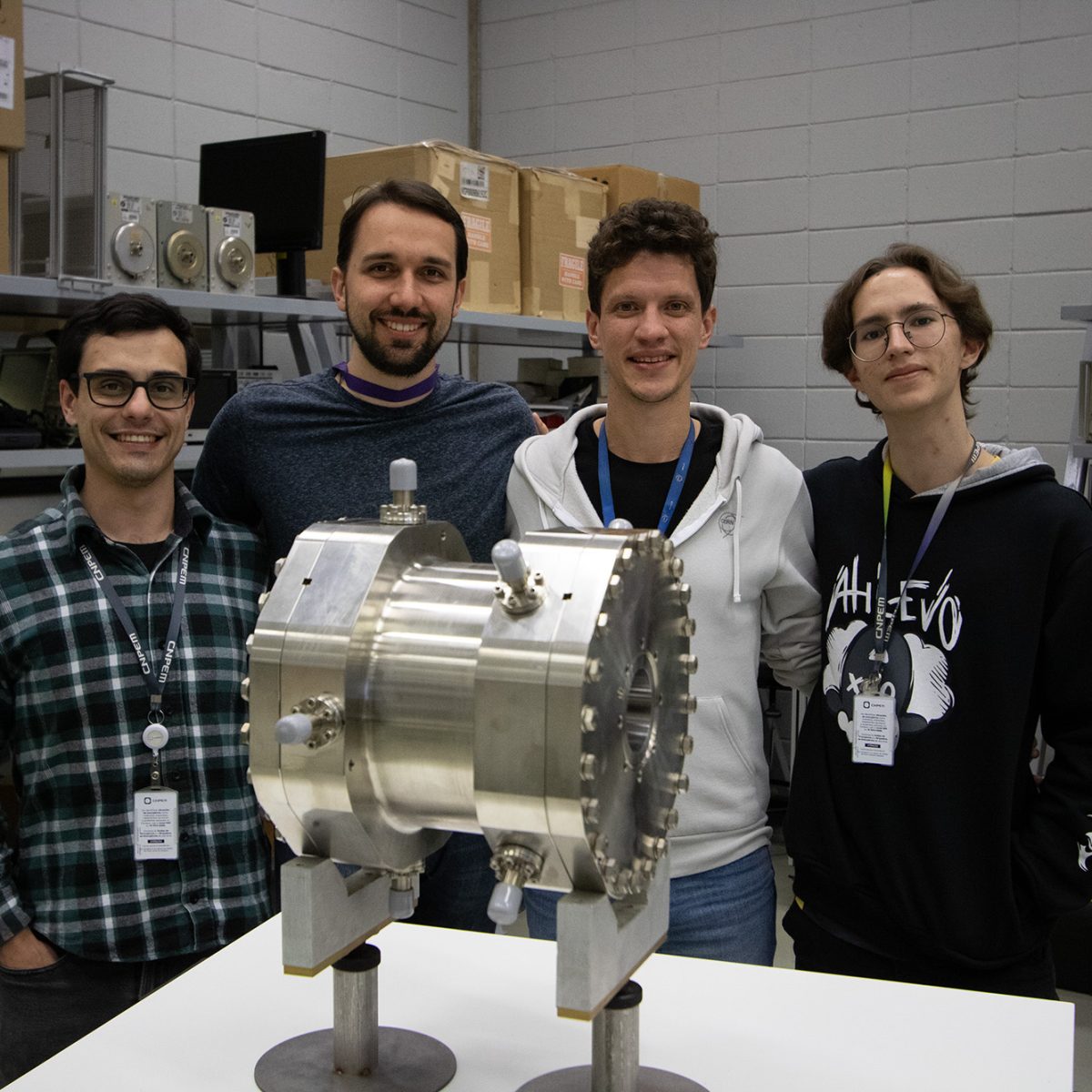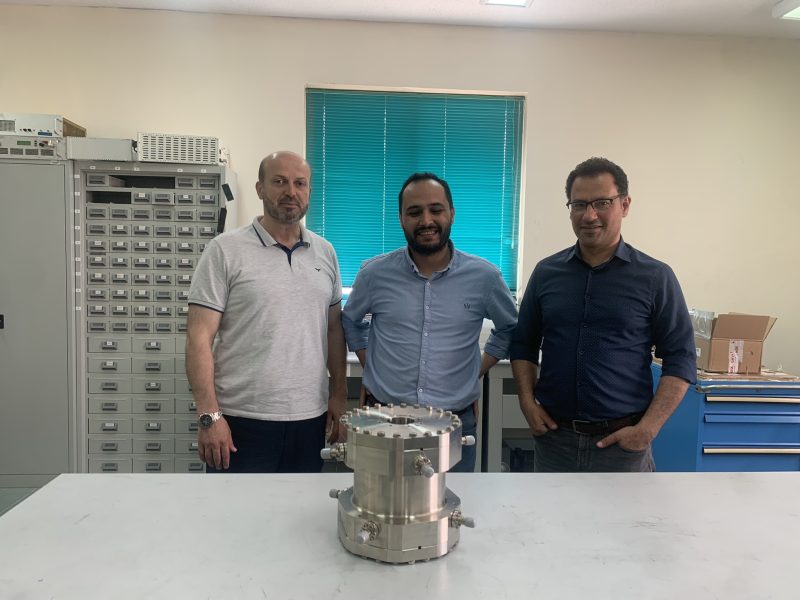
CNPEM members with the kicker before shipping. Left to right: Iago Carvalho de Almeida, Mark Hoffman Wallner, André Lima, Thiago Villar de Carvalho.
Longitudinal kicker, a device used in the first Brazilian particle accelerator that is not compatible with Sirius, will become part of Jordan’s SESAME facilities
An important component of UVX, the first particle accelerator constructed by the Brazilian Synchrotron Light National Laboratory (LNLS) at the Brazilian Center for Research in Energy and Materials (CNPEM) which operated from 1997 to 2019, will be useful for research activities at the Synchrotron-Light for Experimental Science and Applications in the Middle East laboratory (SESAME), the only synchrotron light source in that region.
SESAME is a research center located in Jordan’s Balqa province. It was created under the auspices of UNESCO with support from CERN (the European Organization for Nuclear Research), which is responsible for the Large Hadron Collider, the world’s largest particle accelerator. The objective of SESAME is to use scientific diplomacy to promote a culture of peace and cooperation in the Middle East, bringing together scientists and researchers from various countries in the region to collaborate on research and scientific development projects.
The kicker for the longitudinal bunch-by-bunch feedback system was produced internally at CNPEM for use in UVX, which was deactivated in 2019 after the commissioning of Sirius, one of only three fourth-generation accelerators currently operating worldwide.
The kicker works along the longitudinal parameters of bunches of electrons in the storage ring, reducing what are known as coupled-bunch instabilities (CBIs) that degrade beam quality and limit the storable current. A cavity-type kicker, like the one used at UVX, is part of the feedback system and makes it possible to generate electric fields in line with the direction in which the electron bunches are propagated, synchronized on the scale of picoseconds in order to speed up or slow down the electron bunches that are out of phase.
Because Sirius was constructed with different project parameters and technologies than its predecessor, it was only able to use a small portion of UVX’s vacuum components. The difference in frequency of operations and vacuum chamber dimensions made it impossible to reuse many of these items.
The synchrotron light source at SESAME has a storage ring measuring 133 meters in circumference, and the donated kicker will be incorporated into the bunch-by-bunch feedback system to control instabilities and improve the quality of the electron beam used to generate synchrotron light.
Nashat Sawai, a radiofrequency systems engineer at SESAME, described the donation of this part as invaluable – “The LNLS UVX Longitudinal Cavity Kicker is an invaluable addition to SESAME’s suite of equipment. It will play a crucial role in our efforts to control electron bunches in the storage ring. By precisely adjusting the longitudinal properties of the electron bunches, this technology will enable us to conduct more accurate and intricate experiments. This donation is a testament to the confidence and support of LNLS/Sirius (CNPEM) in our mission and the potential impact of our research. We are grateful for their trust and recognize the significance of their contribution in advancing scientific progress in SESAME region.”.

SESAME staff after receiving the component. Left to right: Maher Attal, Technical Director; Nashat Sawai, RF engineer; Darweesh Foudeh, Leader of the RF group.
As stressed by Harry Westfahl, director of the Brazilian Synchrotron Light National Laboratory, “Science progresses as a collective global endeavor. The LNLS has always benefited from the knowledge and support of other synchrotrons throughout its history. It’s only fair to do the same, particularly to put a piece of equipment to good use that was vitally important at UVX, and now can be very useful at SESAME. The research that can be conducted with the aid of this component will certainly benefit the field of physics and all of accelerator science.”
About the CNPEM
With a sophisticated and vibrant environment for research and development that is the only one of its kind in Brazil and found in only a few scientific centers in the world, the Brazilian Center for Research in Energy and Materials (CNPEM) is a private, non-profit organization overseen by the Ministry of Science, Technology and Innovation (MCTI). The Center operates four national laboratories and is home to Sirius, the most complex project in Brazilian science and one of the world’s most advanced synchrotron light sources. The CNPEM is home to highly specialized multi-thematic teams, globally competitive lab infrastructure that is open to the scientific community, strategic lines of research, innovative projects in partnerships with the productive sector, and training for researchers and students. The Center is an environment driven by research into solutions that impact the areas of health, energy and renewable materials, agri-environmental, and quantum technologies. In 2022, with support from the Brazilian Ministry of Education (MEC), the CNPEM expanded its activities with the opening of the Ilum School of Science. This interdisciplinary undergraduate program in science, technology, and innovation implements innovative ideas to provide a high-quality free and full-time undergraduate program immersed in the research environment at the CNPEM. The CNPEM 360 Platform provides visitors with a virtual immersive visit to the Center’s main environments and activities. Visit at: https://pages.cnpem.br/cnpem360/.
Sirius, the Brazilian particle accelerator, will play a leading role in projects with research centers and universities
In this edition, RAU will be held in November and will feature 4 satellite events.